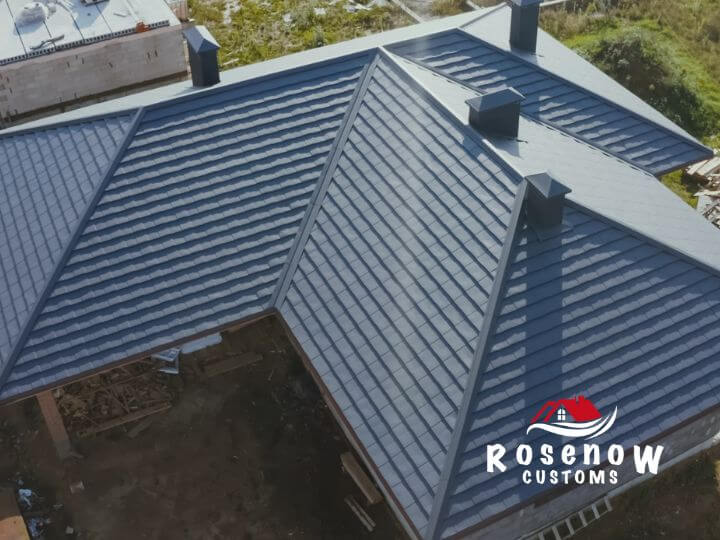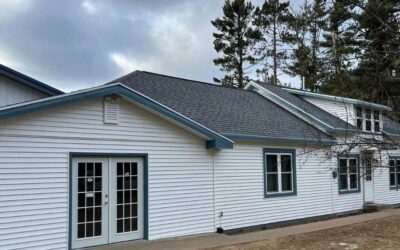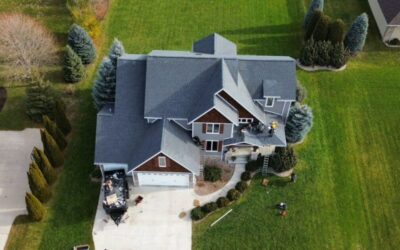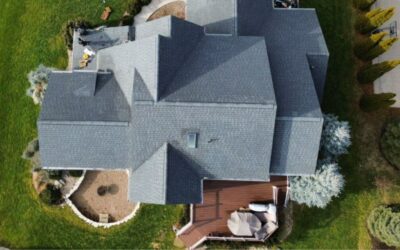Why Choose Metal Roofs for Residential Roof Replacement?
Embarking on a residential roof replacement project necessitates a pivotal decision – the selection of the roofing material. Amidst a plethora of options, from asphalt and wooden shingles to clay tiles, metal emerges as a compelling choice, a specialty of Rosenow Customs, a leader in the roof replacement industry. With remarkable durability, impressive longevity, superior energy efficiency, and a nod to environmental sustainability, metal roofs have carved a niche for themselves in the roofing industry. They are increasingly becoming the go-to option for homeowners in search of a long-lasting and advantageous roofing solution. As we delve deeper into this article, we will uncover the reasons that make metal roofs a potentially ideal choice for your home.
Superior Durability and Longevity
The decision to opt for metal in your residential roof replacement brings with it the promise of unparalleled durability and an extended lifespan. Traditional roofing materials such as asphalt shingles have a life expectancy of 20 to 30 years. In contrast, metal roofs can serve you well for anywhere between 40 to 70 years, contingent on the specific metal type. This implies that metal roofs can outlast conventional roofing materials by a factor of three to seven.
Metal roofs exhibit resistance to cracking, shrinking, and eroding, and they hold their own against severe weather conditions, including heavy snow, hail, scorching temperatures, and even hurricanes. The interlocking panels incorporated into their design endow metal roofs with superior wind resistance, setting them apart from other roofing materials.
The extended lifespan of metal roofs translates into reduced life cycle costs. While the upfront investment may be higher than some other materials, the longevity of a metal roof, coupled with minimal maintenance, results in lower overall costs over time. Hence, if you intend to reside in your home for an extended period, a metal roof can prove to be a cost-effective choice.
Lastly, the durability of a metal roof offers homeowners the assurance that their home is safeguarded for the long haul. This can enhance the resale value of the home, ensuring a favorable return on investment.
Energy Efficiency
Metal roofs are a standout choice when it comes to energy efficiency. They possess a high solar reflectance and thermal emissivity, which means they have the ability to bounce back the sun’s rays rather than soaking them up like conventional roofing materials. This unique feature aids in maintaining a steady indoor temperature, cutting down on the need for artificial cooling in the summer and heating during the winter months.
To add to their energy-saving prowess, many metal roofs are equipped with special coatings that boost their reflective properties. These cool roofs have the potential to slash energy costs by a substantial 10-25%, leading to significant savings over the roof’s lifetime.
Moreover, in an era where energy costs are on an upward trajectory and environmental awareness is gaining momentum, an energy-efficient home could potentially boost its market value. Potential buyers are increasingly seeking out properties with energy-saving features, understanding that these homes will be less expensive to heat and cool throughout the year, which can help balance out the initial investment.
In essence, a metal roof not only aids in reducing your energy expenditure and enhancing your home’s comfort, but it also serves as a sound investment for the future.
Environmentally Friendly
Choosing a metal roof for your residential roof replacement is a decision that benefits not just you, but also the environment. Metal roofs are recognized as a more environmentally friendly option compared to other roofing materials for several reasons.
To begin with, metal roofs are often crafted from recycled materials, and when they’ve served their purpose, they can be entirely recycled again. This significantly reduces the strain on our landfills, a stark contrast to many traditional roofing materials that contribute to the millions of tons of waste generated in the United States annually.
Furthermore, the impressive lifespan of metal roofs lessens the need for frequent replacements, which would otherwise require more raw materials and produce additional waste.
Lastly, as discussed in the previous section, the energy efficiency of metal roofs contributes to a reduction in the home’s energy consumption, thereby shrinking the household’s carbon footprint.
In conclusion, opting for a metal roof for your residential roof replacement is an environmentally conscious choice that promotes sustainability.
Factors to Consider When Choosing a Metal Roof
Opting for a metal roof for your residential replacement is a significant decision that comes with numerous benefits. However, it’s essential to balance these advantages with some key considerations. These include understanding the financial commitment, the installation process, and the maintenance requirements.
The cost of a metal roof extends beyond the initial purchase of materials. It includes installation expenses, potential upkeep costs, and the long-term savings you stand to gain. The installation process is another crucial factor, as it involves understanding your home’s structure, adhering to local building codes, and finding skilled professionals for the job. Lastly, being aware of the maintenance needs of a metal roof will ensure its longevity and peak performance.
In the following sections, we will explore these considerations in more detail. This comprehensive overview will provide you with the necessary insights to make an informed decision about whether a metal roof is the right choice for your home.
Cost Implications
The financial aspect of installing a metal roof is a critical factor to consider. While the initial cost of metal roofing can be higher than traditional roofing materials, it’s essential to look at the bigger picture. The initial investment varies based on the type of metal, the roof’s design, and your geographical location.
However, the long-term value of a metal roof is where the real savings lie. Thanks to their robust nature and minimal maintenance needs, metal roofs can result in significant savings over time. For example, while you may need to replace asphalt shingles every 15-20 years, a well-cared-for metal roof can last half a century or more. This durability translates into fewer repair costs and delays the need for a full roof replacement, offsetting the initial investment.
Additionally, the energy efficiency of metal roofs can lead to considerable savings on your energy bills. However, to maximize these savings, it’s crucial to engage a reputable, experienced roofing installer.
In essence, while the initial cost of a metal roof may be higher, the long-term financial benefits make it a worthy investment for many homeowners.
Installation Requirements
Embarking on a metal roof installation journey involves several crucial steps. The roof’s slope is a primary factor to consider, as metal roofing materials excel on steep slopes, promoting efficient precipitation runoff and reducing the risk of moisture damage.
The lightweight characteristic of metal roofs eliminates the need for extra structural support, making them a versatile choice for various residential buildings. However, a consultation with a roofing expert is indispensable to evaluate your home’s compatibility with a metal roof.
Investing in a high-grade underlayment is a strategic move for metal roofs, given their longevity. This additional layer can boost the roof’s resilience and offer further protection against potential water damage.
The expertise of a roofing contractor in metal roof installation is paramount, as the material’s unique properties require specialized handling. A flawed installation can undermine the roof’s durability and efficiency, potentially leading to additional expenses in the future.
It’s also crucial to familiarize yourself with the local building codes and requirements for roof replacements, which differ across municipalities, to circumvent any compliance issues during the installation process.
Taking into account these considerations, a thorough evaluation of your home and the expertise of a professional installer are the cornerstones of a successful and sturdy metal roof installation.
Maintenance Needs
Despite their reputation for durability, metal roofs still require a certain degree of maintenance to preserve their integrity and extend their lifespan.
Metal roofs, while robust, can be vulnerable to scratches or punctures from severe weather events or falling tree branches. Regular inspections for surface damage are therefore recommended. Any damaged areas should be swiftly treated with a metal roof sealant to avert potential leaks.
In regions with high humidity or heavy rainfall, metal roofs, though generally resistant to moss and fungus, may still be prone to mildew or mold growth. Regular cleaning can mitigate this risk and maintain the roof’s aesthetic appeal.
It’s also vital to keep your metal roof clear of debris. Accumulated leaves, pine needles, and other debris can trap moisture, potentially leading to corrosion over time. Regular cleaning can help avoid this issue.
If your metal roof is painted, periodic repainting may be necessary to keep its visual appeal intact. However, this is typically less frequent than with other roofing materials.
Lastly, ensure gutters and downspouts are free from debris to facilitate proper drainage.
While these maintenance tasks are essential, the overall upkeep requirements of a metal roof are still relatively low compared to other roofing materials, contributing to its popularity.
Aesthetic Advantages of Metal Roofs
Metal roofs are not just about durability and efficiency; they also bring a unique aesthetic appeal to your home. The versatility of metal as a roofing material opens up a plethora of design possibilities, allowing your home to stand out in the neighborhood while also increasing its value.
Metal roofing materials are available in an extensive range of styles and colors, and they can be adapted to various architectural designs. This flexibility enables you to tailor the look of your roof to your personal taste and the existing design of your home.
Let’s delve deeper into the aesthetic benefits of metal roofs, focusing on the variety of styles and colors available, and their adaptability to different architectural styles. This exploration will give you a comprehensive understanding of the design options at your disposal when considering a metal roof for your home.
Range of Styles and Colors
One of the standout aesthetic benefits of metal roofs is the wide array of styles and colors they offer. Unlike traditional roofing materials, metal roofs come in diverse styles such as standing seam, metal shingles, metal tiles, and even metal shake-style roofing. This variety significantly expands your design options.
Each style can be tailored to reflect your unique aesthetic preferences and harmonize with your home’s architectural design. For example, you might opt for metal shingles that replicate the look of traditional shingles, or choose standing seam for a more contemporary, distinctive appeal.
When it comes to color, the options are almost limitless. You can choose natural metals like copper, zinc, or aluminum, which develop a unique patina over time. Alternatively, you can select a pre-painted metal roof in a wide range of colors, from traditional earth tones to more vibrant, modern hues. This flexibility gives you considerable control over your roof’s final appearance.
These colors are typically baked on in a factory setting to ensure they remain vibrant and fade-resistant, even when exposed to harsh weather conditions.
In essence, the vast selection of styles and colors offered by metal roofing empowers homeowners to personalize their roof’s aesthetics, ensuring it perfectly complements their home’s overall design.
Compatibility with Various Architectural Styles
The adaptability of metal roofs to a wide array of architectural styles is one of its standout features. This versatility enhances the aesthetic appeal of any home, regardless of its design.
For instance, a standing seam metal roof, with its sleek lines, can add a touch of modernity and minimalism to contemporary homes. This style also complements industrial-style homes, reinforcing their raw, utilitarian look.
Alternatively, traditional or rustic homes can also benefit from metal roofing. Metal shingles or shake-style roofing can replicate the appearance of classic materials such as wood or slate. This combination of traditional aesthetics with the durability and longevity of metal offers a unique advantage.
Historic or period-style homes can also find a match in metal roofing. Materials like copper or zinc, which were prevalent in the past, can lend an authentic touch. Over time, these metals develop a natural patina, creating a distinctive, aged look that enhances the home’s historical allure.
For homes in coastal areas exposed to saline conditions, corrosion-resistant metals like aluminum or galvanized steel can offer dual benefits. These materials can maintain the home’s beachside aesthetic while withstanding harsh marine conditions.
In summary, metal roofing can enhance the aesthetic appeal of any architectural style, demonstrating its broad compatibility.
Performance of Metal Roofs Under Different Weather Conditions
A roof’s ability to perform under various weather conditions is a critical measure of its functionality. In this regard, metal roofs stand out due to their durability, water management, and heat resistance.
Metal roofs are designed to withstand adverse conditions, be it heavy snowfall, torrential rain, intense heat, or high winds. Each of these weather conditions poses a unique challenge to a roof’s integrity. However, metal roofs showcase exceptional resilience while preserving their aesthetic appeal.
In the following sections, we will explore in detail how metal roofs handle rain and snow, and their resistance to heat and fire. This information will provide a comprehensive understanding of how a metal roof can ensure the safety, comfort, and integrity of your home, irrespective of the weather conditions.
Management of Rain and Snow
Metal roofs are a top-tier choice when it comes to handling precipitation such as rain and snow. Their sleek, hard surface and interlocking design work together to prevent substantial accumulation of precipitation.
Consider a heavy rainstorm. The rainwater will glide off the smooth surface of a metal roof, reducing the risk of water pooling that could lead to leaks or structural damage.
In regions with snowy winters, the benefits of a metal roof become even more apparent. The roof’s slick surface allows snow to slide off, preventing heavy build-up that could cause ice dams or put undue pressure on the roof structure. Furthermore, many metal roofs have a dark surface that absorbs sunlight, aiding in the rapid melting of snow and reducing its duration on the roof.
Some metal roofs even feature built-in channels to guide water runoff, enhancing their ability to manage rain. When paired with well-maintained gutters and downspouts, these roofs can effectively handle heavy rainfall and melting snow, directing it away from your home’s foundation.
Lastly, the natural water-resistant properties of metal, combined with professional installation to seal overlapping panels and protect fasteners, result in a watertight roof capable of withstanding heavy rain and snowstorms.
Resistance to Heat and Fire
Metal roofs are renowned for their resistance to heat and their non-combustible nature, making them a superior choice for fire safety.
In hot weather and direct sunlight, metal roofs excel due to the reflective properties of the material. A significant portion of the sun’s rays are reflected off the metal, reducing heat gain inside your home. This can lead to a cooler interior and substantial energy savings during the hot summer months by lessening the demand on your air conditioning system.
In terms of fire resistance, metal roofs earn a Class A rating, the highest available. They will not ignite or fuel a fire, providing an additional layer of security for your home. While the roof’s underlayment and overall structure also contribute to the fire rating, a metal surface provides a superior level of protection compared to many traditional roofing materials.
Additionally, metal roofs are resistant to damage from stray embers, a common hazard in areas prone to wildfires. If an ember lands on a metal roof, it lacks the necessary fuel to ignite a fire. While no roof can provide absolute protection from fires, a metal roof significantly reduces the risk, offering a level of peace of mind that is uncommon with other roofing materials.





